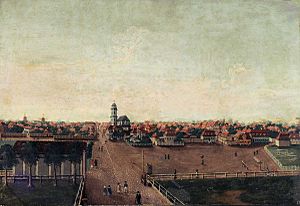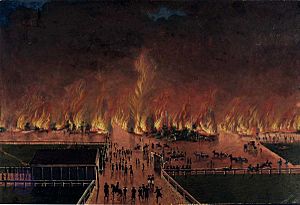Siege of Riga (1812) facts for kids
Quick facts for kids Siege of Riga |
|||||||
|---|---|---|---|---|---|---|---|
| Part of the French invasion of Russia | |||||||
 Siege of Riga depicted in a postcard. |
|||||||
|
|||||||
| Belligerents | |||||||
| Commanders and leaders | |||||||
| Units involved | |||||||
| X Corps | Garrison of Riga Army of Finland |
||||||
| Strength | |||||||
| 31,000 men and 130 siege guns | 27,000 | ||||||
The Siege of Riga was an important military event during the Napoleonic Wars. It lasted for five months, from July to December 1812. During this time, a part of Napoleon's huge army, called the "Great Army," tried to capture the port city of Riga. Riga was a key city in the Russian Empire, located on the Daugava River. The French and their allies wanted to gain a good position to attack the city. However, they could not cross the Daugava River, so the siege was never fully completed.
Contents
Why the Siege Happened
When Emperor Napoleon invaded Russia, he sent two groups of soldiers towards the Baltic Sea. This was to protect his northern side. One of these groups, led by Marshal Étienne MacDonald, was called the X Corps. They were sent towards Courland and then moved towards Riga.
By the middle of July 1812, Riga had about 14,000 Russian soldiers defending it. Soon after the siege began, the Russian Army of Finland arrived with another 10,000 soldiers. This army was led by Fabian Steinheil.
The French army, with about 25,000 soldiers under Marshal MacDonald, faced a difficult situation. They had to continue the siege and also control about 80 miles of the Daugava River. The loyalty of their Prussian allies was also uncertain, which made things even harder for the French.
Key Events of the Siege
On July 7, a battle took place called the Battle of Iecava. Prussian General Julius von Grawert's troops, who were moving towards Riga, defeated the forces of General Friedrich von Löwis of Menar. The Governor-General of Riga, Magnus Gustav von Essen, thought the enemy was stronger than they were. He ordered the suburbs of Riga to be burned to prevent the French from using them.
On July 11, the police were told to start the fires. But the fire, strong winds, and poor planning caused more damage than intended. It harmed many people living in the city.
On July 19, 67 Russian gunboats arrived in Riga. These were many more than the British had. At this time, the Prussian forces were positioned around Riga. Russian forces launched a counterattack, supported by Russian and English gunboats. These boats moved up the Lielupe River and reached Sloka and Kalnciems. They even shelled Jelgava, but had to retreat because of Prussian artillery fire. However, the Prussians soon pushed the Russians back.
On August 10, the Russians attacked Kekava after faking attacks in other directions. They forced their opponents to retreat. On August 26 (September 7), the Prussians counterattacked, and the Russians had to retreat to their starting positions.
Jacques Macdonald, who was based in Dünaburg (Daugavpils), had not been very active. Napoleon then sent more troops to help him take Riga. About 130 large "siege" cannons were placed in Pilsrundāle. But Napoleon himself told Macdonald not to rush, hoping for peace talks that never happened.
On August 9, 1812, British Rear Admiral Thomas Byam Martin decided he was no longer needed in Riga. He got permission to leave, but first, he led British and Russian ships on a raid. They attacked the French port of Danzig. This caused so much panic that Macdonald had to send some of his troops from Daugavpils to calm things down.
On September 10, a group of 10,000 soldiers, called the Steinheil Corps, arrived in Riga from Helsinki. They were ordered to help the Riga defenders push the enemy away and destroy their siege cannons. Now, the Russians had more soldiers (22,000-25,000) compared to the Prussians (17,000). They attacked towards Pilsrundale. But Steinheil and Essen, the Governor-General, disagreed on what to do. Essen wanted to free Jelgava, so their forces split up.
On September 14 (26), Steinheil defeated a group of Prussian troops. York von Wartenburg, who was protecting Jelgava, decided to leave the city without a fight. He joined the Pilsrundale group because he feared being surrounded. The Russians captured Jelgava and a lot of war supplies. This made Essen feel he had made the right choice. However, this delay weakened Steinheil's forces. The Prussians used this chance to attack and forced Steinheil to retreat. Jelgava was also lost again, as Essen fled, and the Prussians reoccupied the city.
In mid-October, the Russians tried to attack again, but the Prussians held their positions.
These military failures led to changes in leadership. On October 14 (26), Filippo Paulucci replaced Essen. The Steinheil Corps was then placed under Peter Wittgenstein, who was doing well in battles nearby.
Meanwhile, the French troops pushing Macdonald from the east towards Riga were successful. On November 1, they captured Tome, taking many Russian officers and soldiers prisoner. The next day, more victories followed. As the weather grew colder, people in Riga worried that once the Daugava River froze, the Prussian forces would have no natural barriers. They prepared for winter defense. But on December 8, the Prussian forces, following orders from Macdonald and the rest of Napoleon's army, began to leave Russia.
What Happened After
The battles caused a lot of economic damage. Both armies took supplies from the area, and parts of Riga were burned down. The new ideas that the French brought to other parts of Europe did not reach Latvia in the same way.
A monument was built in Riga in 1913 for Barclay de Tolly. In 1915, the monument was moved out of the city because of war and was lost at sea. However, it was rebuilt in 2002.
Impact on Riga
On July 12, 1812, a large part of Riga was burned down. This included the Moscow and St. Petersburg suburbs. At least 4 churches, 36 warehouses, 35 government buildings, and 705 homes were destroyed. Many other buildings were also burned.
Forces Involved
Here are some of the main groups of soldiers who fought in the siege:
French X Corps
| French X Corps |
|---|
|
Russian Forces
Riga Garrison
| Riga Garrison |
|---|
|
| Russian Reinforcements |
|---|
Reinforcements/Other Forces
|
British Baltic Fleet
| British Baltic Fleet |
|---|
|
See Also



